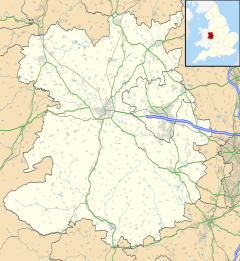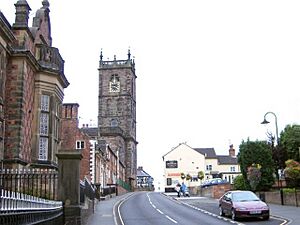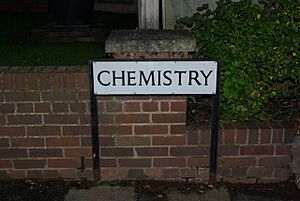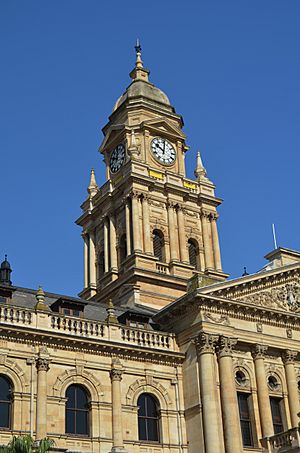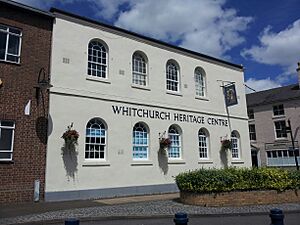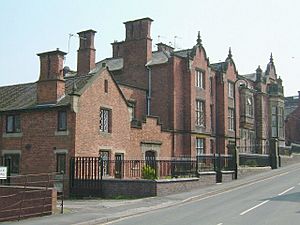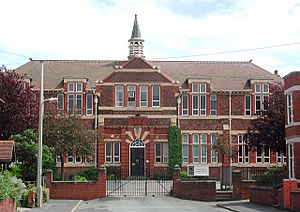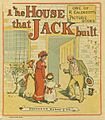Whitchurch, Shropshire facts for kids
Quick facts for kids Whitchurch |
|
|---|---|
 Black Bear Inn, at the junction of Church Street and High Street |
|
| Population | 10,141 (2021) |
| OS grid reference | SJ541415 |
| Civil parish |
|
| Unitary authority |
|
| Ceremonial county | |
| Region | |
| Country | England |
| Sovereign state | United Kingdom |
| Post town | Whitchurch |
| Postcode district | SY13 |
| Dialling code | 01948 |
| Police | West Mercia |
| Fire | Shropshire |
| Ambulance | West Midlands |
| EU Parliament | West Midlands |
| UK Parliament |
|
Whitchurch is a busy market town in the north of Shropshire, England. It is close to the borders of Wales and Cheshire. The town is about 20 miles (32 km) north of Shrewsbury, the county town. It is also about 20 miles (32 km) south of Chester.
In 2021, about 10,141 people lived in Whitchurch. It is the oldest town in Shropshire where people have lived continuously. Famous people from Whitchurch include the composer Sir Edward German and the illustrator Randolph Caldecott.
Contents
- Discover Whitchurch's Past
- How Whitchurch is Run
- Famous Places in Whitchurch
- Getting Around Whitchurch
- Whitchurch's Economy
- Arts and Culture in Whitchurch
- Sports in Whitchurch
- Local News and Media
- Education in Whitchurch
- Places of Worship
- Famous People from Whitchurch
- Twin Town
- Images for kids
- See also
Discover Whitchurch's Past
Whitchurch started as a Roman settlement around AD 52 or 70. The Romans called it Mediolanum, which means "Midfield" or "Middle of the Plain." It was on an important Roman road between Chester and Wroxeter. You can see Roman items at the Whitchurch Heritage Centre.
In 1066, the town was known as Weston. This name likely came from its location on the western edge of Shropshire. By 1086, when the Domesday Book survey was made, the town was called Whitchurch. Its name means "White Church" in Middle English. This refers to a church built from white stone during the Norman period. It is thought that the first Earl of Surrey built this church.
Because Whitchurch was near the Welsh border, its lords had to keep up military activity. There was a castle in Whitchurch, possibly built by William de Warenne, the first Earl of Surrey.
Later History of Whitchurch
In the 12th century, Whitchurch was part of a larger area called Bradford Hundred. Today, the main church is St Alkmund's. It is an Anglican parish church. It was built in 1712 using red sandstone. This church stands where an older Norman church used to be. It is a very important building, protected as a Grade I listed building.
The Whitchurch Cemetery has 91 burials from the Commonwealth War Graves Commission. Twenty-four are from the First World War. Sixty-seven are from the Second World War. Many of these are Polish or Czechoslovak soldiers. This is because a Polish hospital was nearby during the war.
How Whitchurch is Run
Town Council
Whitchurch has its own town council. This council looks after things like street lights, local parks, and the civic centre. The civic centre is in the middle of town. The council also plans events like markets and the Christmas Lights.
In 1894, the original Whitchurch parish was divided. It became "Whitchurch Urban" (the town) and "Whitchurch Rural" (the countryside around it).
County Council
The town is part of Shropshire Council. This is the local government for most of Shropshire. It handles many services for the area. People in Whitchurch elect three councillors to this council.
National Government
Whitchurch is in the North Shropshire parliamentary constituency. This area elects one MP to the UK Parliament. The current MP is Helen Morgan from the Liberal Democrats. She was elected in 2021.
Famous Places in Whitchurch
Buildings to See
Whitchurch has over 100 listed buildings. These are buildings that are protected because they are historically important.
St Alkmund's Church is a key landmark. It was rebuilt in 1712–13 and is a Grade I listed building. Other old buildings include the former almshouses (built in 1697) and the old girls' school (1708). The old Whitchurch Grammar School building from 1708 is also listed. These old school buildings are now flats.
Some of the oldest buildings are the Old Eagles pub from the 16th century. Also, 17, 19, and 21 Watergate Street, known as Raven Yard Antiques, were built in 1625. They were once called the Raven's Inn. Part of Raven Yard Antiques has been restored to its original half-timbered look.
Street Names Tell Stories
The names of streets in Whitchurch town centre show its long history:
- Roman: Pepper Street is a common name in old Roman towns. It comes from "Via Piperatica," where pepper and spices were sold.
- Norse: Some streets end in 'gate,' which means 'street' in Norse. Examples are Watergate, Highgate, and Bargates. Watergate Street was named after an old Medieval or Roman gate. Other names like Castle Hill refer to the old castle.
- Modern: Some names show local industries. Claypit Street was where clay was dug for bricks. Mill Street was named after a water mill. Bark Hill was where bark was used for tanning leather.
Interesting Place Names
Some areas in Whitchurch have unique names:
- Dodington: This comes from Dodtune, meaning "the settlement of Dodda's people." Dodda was an Anglo-Saxon leader.
- Chemistry: This name comes from a business nearby. It made oak-acid, which was used in the town's tanning industry.
Getting Around Whitchurch
Roads and Buses
Whitchurch is an important stop on the British road network. The A49 and A41 roads both go around the town. This bypass opened in 1992. Roads also connect Whitchurch to Wrexham, Nantwich, Chester, and Shrewsbury. There are bus services from Whitchurch to these nearby towns.
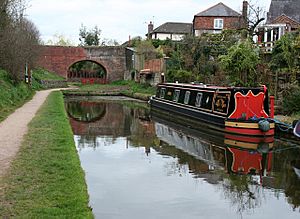
Trains
Whitchurch railway station is on the Welsh Marches Line. This line goes from Crewe towards Cardiff. Whitchurch was once a junction for the Cambrian Railways main line. However, the section from Whitchurch to Welshpool closed in 1965. Another line, the Chester to Whitchurch branch line, closed in 1957.
Canals
Whitchurch has its own short arm of the Llangollen Canal. You can walk about 1 mile along the Whitchurch Waterways Country Park to reach the town centre. This walk is the last part of the Sandstone Trail. Local volunteers manage the Whitchurch Arm of the canal.
Whitchurch's Economy
In the past, Whitchurch was famous for making cheese. Today, Belton Cheese is still a big employer in the town. It has been making cheese since 1922.
The largest employer now is Grocontinental. They help transport food products and employ over 350 people. This family business started in 1941. It was bought by a Dutch company in 2017, and then by Americold in 2020.
Whitchurch also provides many services for the surrounding countryside. Most shops are small or medium-sized businesses. They are mainly on High Street, Watergate Street, and Green End. There are also larger supermarkets like Tesco, Lidl, Sainsbury's, and Aldi.
The town was home to J. B. Joyce & Co, a company that made tower clocks. It started in 1690 and was the oldest tower clock-making company in the world. Joyce's clocks can be found in places like Singapore and Cape Town. The company even helped build Big Ben in London. J. B. Joyce has now moved, and an auction house is in their old building.
Whitchurch has a local business group. This group works to improve the town's business environment.
By train, Whitchurch is about an hour from Liverpool and Manchester. It is about 30 minutes from Shrewsbury.
Arts and Culture in Whitchurch
Whitchurch offers many arts and culture activities, festivals, and groups.
Cultural Activities
- Poetry Whitchurch: This group runs poetry events all year. They have open mic nights for new poetry and discussion groups. They also help local poets develop their skills. They hold spoken word competitions called Poetry Slams once a year.
Cultural Places and Facilities
- Alderford Lake: Hosts various cultural performances.
- Bookshrop: A local bookshop that is a centre for many cultural activities.
- Whitchurch Civic Centre: Hosts performances and has a public library.
- Whitchurch Heritage Centre: A place to learn about the town's history.
- Talbot Theatre: Located at the Sir John Talbot School. It shows plays, music, and films.
- Doodle Alley: A creative space.
- Whitchurch Amateur Operatic and Dramatic Society: A group that performs operas and plays.
- Whitchurch Little Theatre Group: Another theatre group.
Festivals to Enjoy
- Blackberry Fair
- Party in the Park
- Whitchurch Food and Drink Festival
The Sir Edward German Music Festival is also held here. It uses St Alkmund's, St John's churches, and Sir John Talbot's Technology College. The festival includes local choirs, schools, and international musicians.
Historic Cultural Moments
On January 19, 1963, The Beatles played in the old Town Hall Ballroom. This is now the Civic Centre. On the same night, a recording of them was shown on the TV show Thank Your Lucky Stars. This TV appearance helped change their career. Their song "Please Please Me" had just been released.
Sports in Whitchurch
Whitchurch Rugby Club plays in the Midlands 1 West league. This is the sixth level of English rugby. The club started in 1936. It has teams for mini rugby, juniors, and adults. They play at Edgeley Park.
The local football club is Whitchurch Alport F.C.. It was founded in 1946. The club is named after Alport Farm, where a local footballer, Coley Maddocks, lived. He was killed in the Second World War. Since 2015, Whitchurch Alport has played in the North West Counties Football League Premier Division.
The Chester Road Bowling Club started in 1888. It has over 160 members and many teams. Another bowling club, Whitchurch and District, began in 1924.
Whitchurch Leisure Centre is at the Sir John Talbot School. It has many exercise facilities and classes.
The Whitchurch Walkers is a group for people who enjoy walking. They help protect footpaths. They also organize an annual walking festival. The Sandstone Trail starts or ends at the Whitchurch canal arm. It is part of the Shropshire Way.
On the north side of town is the Macdonald Hill Valley Hotel. It has a fitness centre, a swimming pool, and two golf courses.
Since 2019, Alderford Lake has hosted a parkrun. This is a free, timed 5 km run or walk every Saturday morning.
Local News and Media
You can get regional news and TV from BBC West Midlands and ITV Central. TV signals come from the Wrekin TV transmitter.
Local radio stations include BBC Radio Shropshire (96.0 FM), Hits Radio Black Country & Shropshire (103.1 FM), Capital North West & Wales (103.4 FM), and Greatest Hits Radio Black Country & Shropshire (107.1 FM).
The local newspapers are the Whitchurch Herald and the Shropshire Star.
Education in Whitchurch
Whitchurch has a long history of schools. Whitchurch Grammar School started in 1548. It was founded by Rev Sir John Talbot. It was one of England's oldest schools and was only for boys. A school for girls was built next door. Both schools closed in 1936. They became part of the new Sir John Talbot’s School. This school is on the edge of town and has about 500 students aged 11–18.
The main primary school is Whitchurch CE Junior School. It has about 300 pupils aged 7–11. Younger children go to Whitchurch CE Infant and Nursery School.
There is also an active branch of the University of the Third Age. This group offers learning and activities for older adults.
Places of Worship
The most important church in town is St Alkmund's. It is an Church of England parish church. It was built in 1712 from red sandstone. It stands where a Norman church used to be. It is a Grade I listed building. St Catherine's in Dodington was built in 1836. It was a smaller church for St Alkmund's. It is now apartments.
John Wesley, who started the Methodist movement, preached in Whitchurch in 1781. St John's Methodist Church was built in 1879. The old Wesleyan Chapel, which opened in 1810, is now the Whitchurch Heritage Centre.
Other churches that are now closed include the Dodington United Reformed Church (built 1815) and the Dodington Presbyterian Chapel (built 1707). A Baptist chapel from 1820 is now an antique showroom.
St George's Catholic Church has been on Claypit Street since 1878.
The Whitchurch Cemetery has 91 burials from the Commonwealth War Graves Commission. Most are from the Second World War. Many are Polish or Czechoslovak soldiers. The ashes of the composer Sir Edward German are also buried here.
Famous People from Whitchurch
Early Times
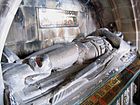
- Sir Henry Percy (1364–1403): Also known as Sir Harry Hotspur. He was killed at the Battle of Shrewsbury.
- Sir John Talbot (c. 1384–1453): A brave warrior. His heart is buried under the porch of St Alkmund's Church. He is a character in Shakespeare's Henry VI, Part I.
- Rev. Sir John Talbot (c. 1490–1549): He founded Whitchurch Grammar School in 1548.
- Abraham Wheelock (1593–1653): A linguist and professor at Cambridge University.
- Nicholas Bernard (c. 1600–1661): A writer and clergyman.
- Philip Henry (1631–1696): A nonconformist clergyman.
- Joseph Bromfield (1744–1824): A famous plasterer and architect.
- John Pridden (1758–1825): A clergyman and expert on old things.
- Reginald Heber (1783–1826): A bishop who attended Whitchurch Grammar School.
- Thomas Corser (1793–1876): A literary scholar and clergyman.
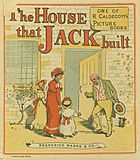
More Modern Times
- Randolph Caldecott (1846–1886): A famous illustrator. He lived in Whitchurch, and the town's buildings appear in his artwork.
- Sir Edward German (1862–1936): A composer born in Whitchurch. He is buried in the local cemetery.
- Lucy Appleby (1920–2008): A traditional cheesemaker.
- Ken Dodd (1928–2018): A comedian and singer. He had a country house near Whitchurch for 50 years.
- Elizabeth Fritsch (born 1940): A famous ceramic artist.
- Lorna Sage (1943–2001): A literary critic and author.
- Owen Paterson (born 1956): A former MP for North Shropshire.
- Judy Hunt (born 1957): The current Rector of Whitchurch.
- Kate Long (born 1964): A novelist, author of The Bad Mother's Handbook.
- Christina Trevanion (born 1981): An auctioneer and TV personality.
Sports People
- Percy Newton (1904–1993): A professional footballer.
- George Antonio (1914–1997): A professional footballer for Stoke City.
- Stuart Mason (1948–2008): A professional footballer who started his career with Whitchurch Alport F.C.
Twin Town
Whitchurch is twinned with Neufchâtel-en-Bray in France.
Images for kids
-
Sir John Talbot's effigy in St Alkmund's Church
-
Stub of the Whitchurch Arm of the Llangollen Canal
-
This Is the House That Jack Built, a book illustrated by Randolph Caldecott.
See also
 In Spanish: Whitchurch, Shropshire para niños
In Spanish: Whitchurch, Shropshire para niños


